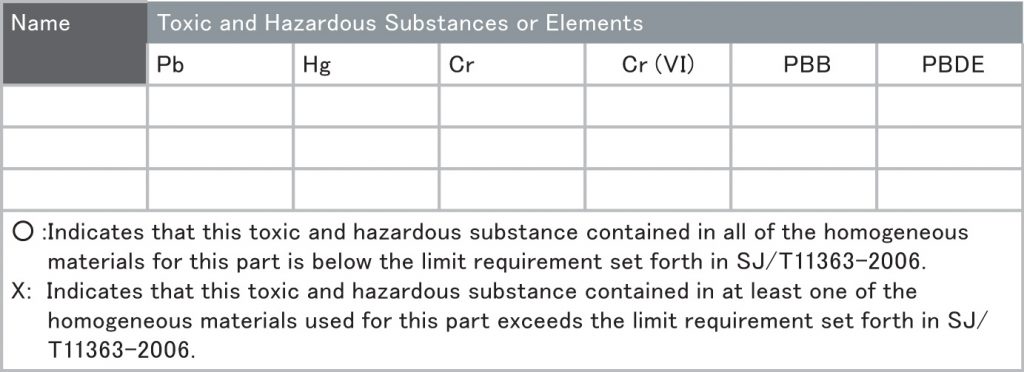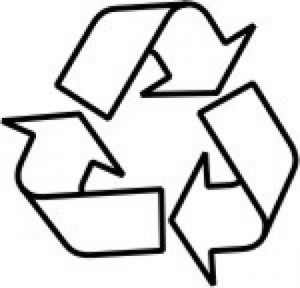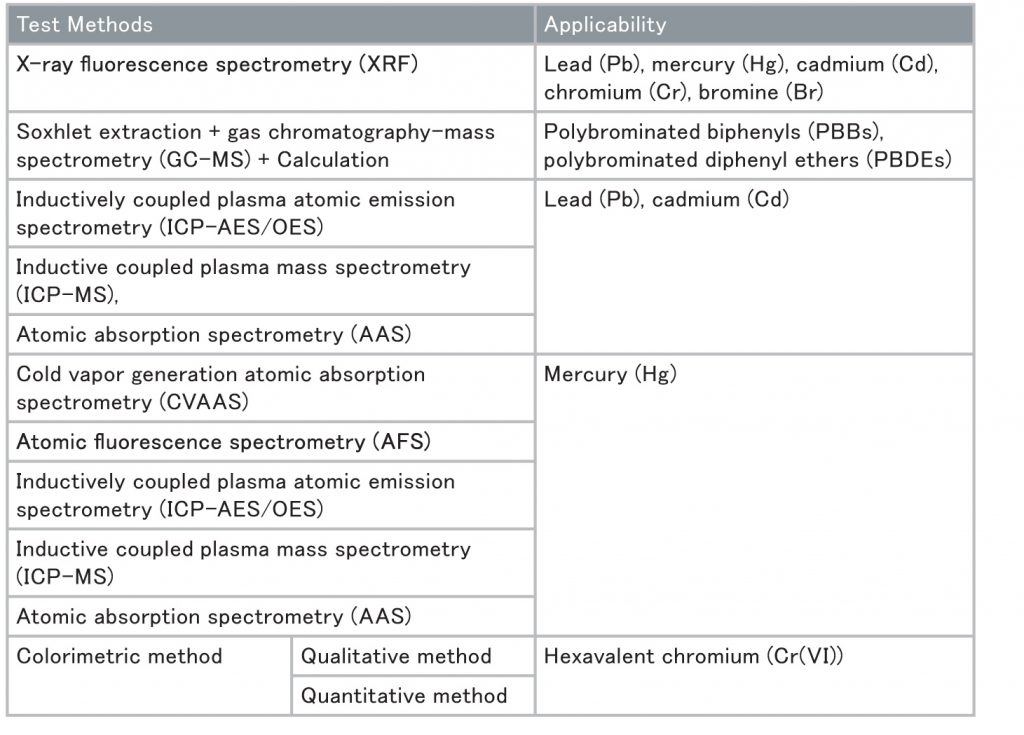Compliance with EU RoHS does not equate to compliance with China RoHS.
Grace Lin
Crestron Electronics, Inc., Rockleigh, NJ, USA
This article provides guidelines to comply with Chinese RoHS regulation, the “Administrative Measure on the Control of Pollution Caused by Electronic Information Products”, which takes effect March 1, 2007. It addresses compliance requirements for Chinese RoHS, including marking requirements, limit requirements, and test methods. It gives readers a complete picture of the Chinese RoHS scheme. For those who are too busy to follow the news, this is the place to start. For those who have followed the news closely, this is a quick review.
Legal Documents
Chinese RoHS regulation is the “Administrative Measure on the Control of Pollution Caused by Electronic Information Products[1]” (the Administrative Measure) promulgated February 28, 2006. The Administrative Measure includes four chapters and twenty-seven articles.
- Chapter 1: General Rules (Articles 1 – 8)
- Chapter 2: Control of Pollution Caused by Electronic Information Products (Articles 9 – 21)
- Chapter 3: Penalty Provisions (Articles 22 – 24)
- Chapter 4: Supplementary Provisions (Articles 25 – 27)
The following three industrial standards, in conjunction with the Administrative Measure, were promulgated November 6, 2006.
- SJ/T 11363-2006[2], “Requirements for Concentration Limits for Certain Hazardous Substances in Electronic Information Products”
- SJ/T 11364-2006[3], “Marking for the Control of Pollution Caused by Electronic Information Products”
- SJ/T 11365-2006[4], “Testing Methods for Hazardous Substances in Electronic Information Products”
In addition, GB 18455-2001[5] is the Chinese national standard for packaging recycling marks. This is the standard for marking packaging materials.
Scope
The Administrative Measure is to control and reduce environmental pollution and other public hazards during the process of manufacturing, selling, and importing electronic information products within the territory of the People’s Republic of China. Exports are exempt from this measure.
Electronic Information Products include the following products and their accessories manufactured by using electronic information technology:
- Electronic radar products
- Electronic communication products
- Broadcast television products
- Computer products
- Household electronic products
- Electronic measurement instrument products
- Electronic products for special use
- Electronic component products
- Electronic application products
- Electronic material products
The “Note for Classification of Electronic Information Products[1]” (the Note), promulgated March 16, 2006, gives a detail list of electronic information products. Any products not listed in this Note are not under the scope of the Administrative Measure. A good example is copiers. Logically, copiers are electronic information products. However, since they are not listed in the Note, they do not fall within the scope of the Administrative Measure.
Regulated subassemblies and/or parts, installed in unregulated products, are not under the scope of the Administrative Measure. However, if regulated subassemblies and/or parts are sold independently, they are subject to the requirements set forth in the Administrative Measure. The “Administrative Measure” covers all the electronic information products in the supply chain. Parts used for service or upgrades during after-sale service are not subject to the “Administrative Measure”. If they are sold independently, they are subject to the “Administrative Measure”.
Secondhand products are not under the scope of the “Administrative Measure”. Export products and materials, components, and parts for export products are not restricted by the “Administrative Measure.”
Effective Date
The Administrative Measure takes effect March 1, 2007, except for Articles 18 – 21. All electronic information products must comply with the requirements set forth in this Administrative Measure.
After the implementation of China Compulsory Certification (CCC Certification or 3C Certification) for electronic information products, the Administrative Measure will be fully implemented. Figure 1 gives a diagram for clarification.

Compliance Requirements
Compliance with EU RoHS does not equate to compliance with China RoHS. The “Administrative Measure” adopts a “two-step approach” method for the control of toxic and hazardous substances in electronic information products. The first step is self-declaration. Starting March 1, 2007, a manufacturer affixes an environmental-friendly logo, as shown in Figure 2 or 3, to the product and indicates environment-friendly information (the names and contents of toxic and hazardous substances, environment-friendly use period, recyclability, and the names of packaging materials, etc.) in the product instruction manuals. There are no requirements for the “substitution” or “limitation” of toxic and hazardous substances or elements during the first step.
The second step is CCC Certification. Once a key administrative catalogue (the Catalogue) has been promulgated and an implementation date has been determined, electronic information products included in the Catalogue are subject to China Compulsory Certification (CCC Certification). As soon as economically feasible, electronic information products will be listed in the Catalogue, a volume that will be updated periodically. Catalogue-listed products face the same restrictions on substances as outlined by the EU RoHS Directive. They must meet the limit requirements set forth in SJ/T 11363-2006. Additionally, testing to determine the amount of regulated substances in Catalogue-listed products must be carried out in one of the designated Chinese laboratories. The implementation date of the second step has not been determined at the time of this writing.


Marking Requirements
Effective March 1, 2007, all electronic information products must bear an environment-friendly logo, as shown in either Figure 2 or Figure 3, depending on whether these products contain toxic and hazardous substances or elements. “Contain” indicates that the contents of toxic and hazardous substances or elements exceed the limit requirements set forth in SJ/T11363-2006.
- For electronic information products containing no toxic or hazardous substances or elements, the logo in Figure 2 applies. The logo can be on the product or indicated in the instruction manual. The recommended color for the logo is green (C: 85, M: 31, Y: 83, K: 20).
- For electronic information products containing toxic or hazardous substances or elements, the logo in Figure 3 applies. The number in the middle of the logo should be replaced with the environment-friendly use period of the product. The logo must be marked on the products if the product surface area is greater than or equal to 5×103 mm3 with a regular shape. For products with maximum surface area smaller than 5×103 mm3 or with an irregular shape, such as thin wires and cables, the logo can be indicated in the instruction manual. The recommended color of the logo is orange (C: 0, M: 75, Y: 99, K: 20).

In addition, the names and contents of toxic and hazardous substances must be indicated in the instruction manual, in a format as shown in Table 1. Product manufacturers can indicate the names and contents with or without testing. If a product manufacturer has a clear understanding of toxic and hazardous substances in a product, indication can be done without test. If this information is not clear, testing is required. Test reports, for the purpose of inclusion in this instance can be carried out by internationally recognized test laboratory. It does not matter where test is performed as long as the indication and related environmental information are correct and consistent. The relevant departments of the State reserve the right to supervise the marketing of electronic information products and to inspect labeling for the inclusion of correct information.
The environment-friendly use period is determined by the manufacturer. It does not need to be approved by the government. A technical document, the “General Rule of the Environment-Friendly Use Period of Electronic Information Products” will be available for enterprises to make a determination in their particular case. The date of manufacture of electronic information products is the starting date of the environment-friendly use period.
The height of Chinese characters and logos of marking should not be less than 1.8mm.

Given the popularity of internationally recognized recycling symbols, paper packaging materials (i.e., Category II of Table 2 under Article 4.2 of GB 18455-2001) can be marked by using either the logo format stipulated in the GB 18455-2001 or the internationally recognized three chasing arrows symbol, or Mobius Loop, as shown in Figure 4.
Limit Requirements
Regulated substances per China RoHS are the same as EU’s. They are lead (Pb), mercury (Hg), cadmium (Cd), chromium (Cr), hexavalent chromium (Cr(VI)), polybrominated biphenyls (PBB), and polybrominated diphenyl ethers (PBDE). The limits for these substances are identical to the those in the EU Directive. However, the compliance scheme is different.

Limits are listed in Table 2. Composition units of electronic information products are categorized into three categories: EIP-A, EIP-B, and EIP-C. If there is any ambiguity or contradiction, the order of EIP-A/EIP-B/EIP-C should be adopted. In other words, if EIP-A applies, then EIP-B and EIP-C are not applicable.
A manufacturers or importer, using toxic and hazardous substances to reach specific product performance indexes will be deemed to have added the substance intentionally if one of the following circumstances apply:
- The content of lead, mercury, and cadmium does not comply with the limit requirements using X-ray fluorescence spectrometry, as stipulated in Article 5 of SJ/T 11365 – 2006
- Hexavalent chromium is detected by using the qualitative colorimetric method, as stipulated in Article 8.1 of SJ/T 11365 – 2006
If any one of the composition units (EIP-A/B/C) is not compliant, the product is not in compliance. There are no exemptions as defined in the EU RoHS Directive (2002/95/EC). Instead, China adopts a Catalogue to determine which products are subject to the restriction. All products included in the Catalogue must comply with the limit requirements as shown in Table 2.
Testing Methods
A test standard, SJ/T 11365-2006, was promulgated in conjunction with the “Administrative Measure”. Sampling methods are included in Appendix A of the standard. The standard provides harmonized test methods for regulated substances. Table 3 lists test methods stipulated in the standard.

Summary
The “Administrative Measure” takes effect March 1, 2007, except for Articles 18 – 21. All electronic information products must indicate environment-friendly information as stated under the Marking Requirements. This is the first step of the two-step approach.
Once the Catalogue has been promulgated and an implementation date has been set, all electronic information products listed in the Catalogue must be CCC certified, in addition to self-declaration, before entering the Chinese market. At that time, the “Administrative Measure” will be fully implemented.
Ministry of Information Industry (MII, www.mii.gov.cn), the leading government agency for China RoHS, has posted frequently asked questions and answers[1] for the Administrative Measure and three SJ/T industrial standards. These two document answer questions that many people may have.
Acknowledgement
The author wishes to express her sincere appreciation to Wayne Owens of Crestron Electronics, Inc. for his support.
REFERENCES
[1] The official Chinese text of this law can be found at http://www.mii.gov.cn/art/2006/03/02/art_521_7344.html. An English translation version is available at http://www.aeanet.org/governmentaffairs/gabl_ChinaRoHS_FINAL_March2006.asp.
[2] An English translation version of this standard is available at: http://www.aeanet.org/governmentaffairs/gajl_MCV_SJT11363_2006ENG.asp.
[3] An English translation version of this standard is available at: http://www.aeanet.org/governmentaffairs/gajl_LABELING_SJT11364_2006ENG.asp
[4] An English translation version of this standard is available at: http://www.aeanet.org/GovernmentAffairs/gamm_ChinaRoHS_TestingMethods.asp
[5] An English translation version of this standard is available at: http://www.aeanet.org/governmentaffairs/gajl_Packaging_GB18455_2001ENG.asp
[6] The official Chinese text of this note can be found at http://www.mii.gov.cn/art/2006/03/16/art_1221_8441.html. An English translation version of this note is available at http://www.aeanet.org/governmentaffairs/gabl_HK_Art3_EIPTranslation.asp.
[7] An official Chinese text of frequently asked Q&A for the Administrative Measure can be found at http://www.mii.gov.cn/art/2006/12/01/art_1221_27258.html. An English translation version is available at http://www.graspllc.com/China%20RoHS%20Q&A%20-%20Measure.php. An official Chinese text of frequently asked Q&A for the three SJ/T standards can be found at http://www.mii.gov.cn/art/2006/12/01/art_1221_27260.html. An English translation version is available at http://www.graspllc.com/China%20RoHS%20Q&A%20-%20Standards.php.
About the Author
Grace Lin is a senior compliance engineer at Crestron Electronics, Inc. She is a NARTE certified test laboratory engineer and has worked in the EMC field for many years. She holds a M.S. degree in electrical engineering from Syracuse University





